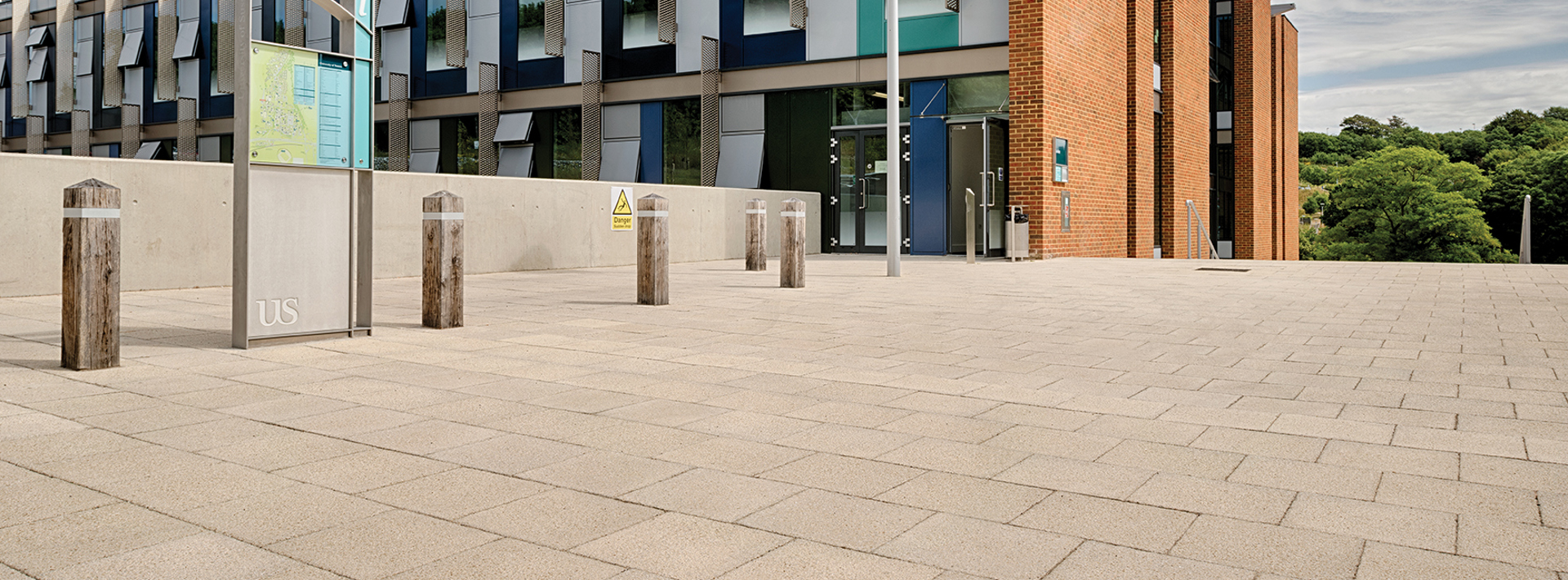Blog
For most people, the pavements and pedestrianised zones in their local area often blend into the background. We give them little thought, yet we use them every single day.
For local authorities and developers, though, any paving in public spaces requires careful planning.
Councils must specify the correct commercial paving slabs to ensure the pavements, precincts, and paved areas are built to withstand heavy usage all year round.
In this guide, we focus on the sizes of council paving slabs and explore the importance of using the correct sized slabs for the application in question.
What are council paving slabs?
Council paving slabs are standard flags used on pedestrianised areas and pathways in cities, towns, and villages in the UK.
The term "council paving" can encompass various types of paving materials and construction methods chosen by councils for their public infrastructure projects.
Councils typically choose concrete paving for these areas due to its durability, aesthetics, cost-effectiveness, and suitability for pedestrian and vehicular traffic.
What sizes do council paving slabs come in?
Typically, council paving slabs are 600mm x 600mm x 63mm (W x L x D).
Since councils use paving slabs in a wide range of environments, though, different thicknesses are available to ensure surfaces can withstand different types of traffic.
Some of the other standard thicknesses (slab depth measurements) available include:
- 50mm
- 60mm
- 70mm
Council paving slabs are also available in large-form rectangular units, each measuring 600mm x 900mm x 63mm.
At Marshalls, we recognise that no two hard landscaping projects are alike, so we provide several different slab-size options in addition to the standard ones already mentioned.
Our Standard Pimple Paving includes square and rectangular slabs in dimensions ranging from 600mm x 900mm to 300mm x 300mm.
Get in touch with the team at Marshalls for support in specifying the best paving solution for your project.
What makes council paving slabs different from other types?
Uniform in size, colour, depth, and overall appearance, council paving is just a standard concrete paving flag that complies with BSEN1339 and is found on pedestrianised areas and pathways. Often slightly pimpled in texture, it helps provide enhanced slip-skid resistance.
What are council paving slabs used for?
Council paving, specifically Standard Pimple Paving, comes in several sizes and depths and therefore has plenty of uses for different council projects, here are a few places you can expect to find this type of paving:
- Footpaths and pavements: Council paving slabs are extensively used for constructing footpaths, pavements, roadside areas, and pedestrian zones adjacent to streets. They provide a durable and stable surface for pedestrians to walk on, enhancing accessibility and safety.
- Public squares and plazas: They are often found in paved public squares, plazas, and open spaces within urban centres.
- Pedestrianised zones: In pedestrianised areas and shared spaces, paving slabs are used to define pedestrian routes and provide a safe and comfortable surface for pedestrians to move around freely.
- Outdoor seating and dining areas: Paving slabs are used to pave outdoor seating and dining areas, such as those outside cafes, restaurants, and public facilities. They provide a stable base for furniture and enhance the usability of outdoor spaces.
- Bus stops and transport hubs: Paving slabs are used around bus stops, tram stations, and transport hubs to provide designated waiting areas for passengers. They contribute to the functionality and accessibility of public transport infrastructure.
What are the pros and cons of council paving slabs
Council paving slabs are hugely popular due to their many benefits, including:
- Easy to replace: The standard sizes and colours mean individual council paving slabs can be replaced like-for-like to easily repair localised damage or cracks. Councils can simply lift the broken slab and lay a new one in its place.
- Durable: These paving slabs are engineered to withstand heavy vehicular loads and constant footfall without breaking or becoming unsafe. Once they’re in place, these slabs provide a practical hard landscaping solution that requires little maintenance.
- Cost-effective: Being easy to replace and highly durable, council pavers are a cost-effective option over their lifetime.
- Widely available: Commercial landscapers often work to incredibly tight deadlines with little room for error, so it's essential to have a paving solution that can be supplied on time and to specification.
For projects where flooding is a concern or aesthetics are a primary focus, council paving might not be the best option.
Council paving slabs are often impermeable (non-porous), which may lead to drainage and surface water issues unless managed with appropriate drainage systems.
Also, although council paving slabs offer a fantastic colour consistency, they don’t provide the same visual appeal as premium concrete paving slabs do.
For greater aesthetic flexibility, we recommend choosing paving options like Modal X, Saxon, Perfecta, Lunar, and natural stone.
For better surface water drainage, we suggest using permeable paving from our Priora permeable paving range.
Choose Marshalls for quality council paving slabs
Here at Marshalls, we have been manufacturing and supplying quality council paving slabs for decades. Our expert teams have even worked in partnership with councils across the country to find ways for them to save money and reduce the carbon footprints of their landscaping schemes.
Contact the team today for support with a bespoke project or to inquire about our standard ranges.










